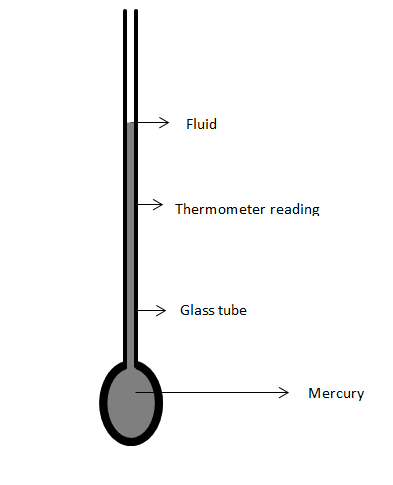
Describe the construction of a laboratory thermometer.
Answer
498.3k+ views
Hint: Laboratory thermometer is constructed on the basis of mercury based thermometers. Thermometers have a thin column of mercury within a glass casing. When the temperature of mercury increases, it expands within the tube. Since the area of the tube is fixed, the expansion causes a rise in height of the mercury column, which is interpreted as rise in temperature.
Complete step by step answer:
Laboratory thermometer consists of a thick walled fine bore glass capillary tube. It has a small thin bulb at its lower end and it is filled with pure /dry Hg or colored alcohol. The portion of the capillary tube above the bulb is commonly called stem. Laboratory thermometer is made in Celsius scale ranging from $ - {10^0}C$ to ${110^0}C$. Laboratory thermometers are constructed on the basis of mercury based thermometers. The wall of the bulb is usually thin. The capillary tube is narrow in nature. This helps in making the thermometer more sensitive.
When a thermometer is used to measure our body temperature the glass wall attains thermal equilibrium with our body. And the mercury which is in contact with the glass wall will eventually reach thermal equilibrium. Using the zeroth law of thermodynamics we can say that our body and mercury are in thermal equilibrium i.e. in same temperature.This is how mercury thermometer measures the temperature.
Though a thermometer needs to be in contact with the system to measure temperature, Physical contact is not always necessary for heat to flow. There are various modes of heat transfer, such as conduction, convection and radiation. Mercury thermometers expand and contract according to the rise and fall of temperature.

Note: We know measure of temperature helps us to determine whether heat will flow from one object to another. Using this law we can determine and compare the temperatures of different objects.
Thermometers are the most elegant example for the Zeroth Law of thermodynamics in action.
Complete step by step answer:
Laboratory thermometer consists of a thick walled fine bore glass capillary tube. It has a small thin bulb at its lower end and it is filled with pure /dry Hg or colored alcohol. The portion of the capillary tube above the bulb is commonly called stem. Laboratory thermometer is made in Celsius scale ranging from $ - {10^0}C$ to ${110^0}C$. Laboratory thermometers are constructed on the basis of mercury based thermometers. The wall of the bulb is usually thin. The capillary tube is narrow in nature. This helps in making the thermometer more sensitive.
When a thermometer is used to measure our body temperature the glass wall attains thermal equilibrium with our body. And the mercury which is in contact with the glass wall will eventually reach thermal equilibrium. Using the zeroth law of thermodynamics we can say that our body and mercury are in thermal equilibrium i.e. in same temperature.This is how mercury thermometer measures the temperature.
Though a thermometer needs to be in contact with the system to measure temperature, Physical contact is not always necessary for heat to flow. There are various modes of heat transfer, such as conduction, convection and radiation. Mercury thermometers expand and contract according to the rise and fall of temperature.

Note: We know measure of temperature helps us to determine whether heat will flow from one object to another. Using this law we can determine and compare the temperatures of different objects.
Thermometers are the most elegant example for the Zeroth Law of thermodynamics in action.
Recently Updated Pages
Master Class 10 General Knowledge: Engaging Questions & Answers for Success

Master Class 10 Computer Science: Engaging Questions & Answers for Success

Master Class 10 Science: Engaging Questions & Answers for Success

Master Class 10 Social Science: Engaging Questions & Answers for Success

Master Class 10 Maths: Engaging Questions & Answers for Success

Master Class 10 English: Engaging Questions & Answers for Success

Trending doubts
A number is chosen from 1 to 20 Find the probabili-class-10-maths-CBSE

Find the area of the minor segment of a circle of radius class 10 maths CBSE

Distinguish between the reserved forests and protected class 10 biology CBSE

A boat goes 24 km upstream and 28 km downstream in class 10 maths CBSE

A gulab jamun contains sugar syrup up to about 30 of class 10 maths CBSE

Leap year has days A 365 B 366 C 367 D 368 class 10 maths CBSE




